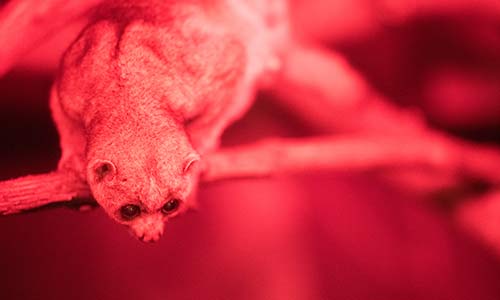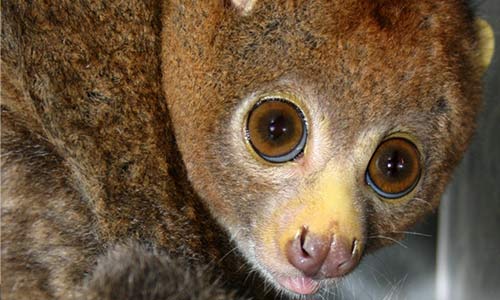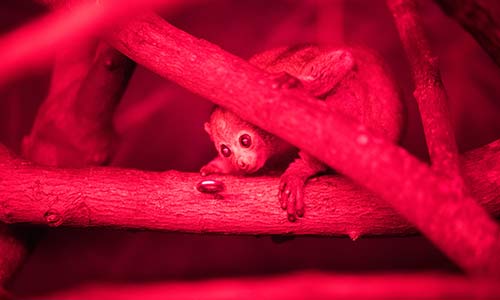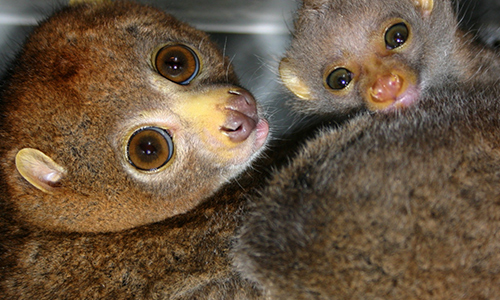Potto
Perodicticus potto
About the Potto

Geographic Range:
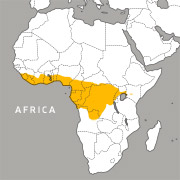
Class: Mammalia
Order: Primates
Family: Lorisidae
Genus: Perodicticus
Species: potto
Pottos are small and compact with brown woolly coats. They have round heads, small ears and golden brown protuberant eyes. They’re solitary and nocturnal creatures, spending their days sleeping high in trees and nights hunting for food (mostly fruit). If threatened, pottos can freeze in place for hours.
Potto Facts
Appearance:
Small and compact, pottos have a dense, woolly coat in various shades of brown; their underside is usually lighter than their back. The potto’s head is round, with small ears and golden brown protuberant eyes. The potto’s strong jaws enable it to eat lumps of dried gum that are too tough for other tree-dwellers. It has a powerful bite and its saliva contains compounds that cause a wound to become inflamed.
Pottos' feet are well adapted to clasping branches. Their thumbs and big toes are oriented at almost a 180-degree angle to their other fingers, while the first (index) finger is reduced in size to a small stub. Consequently, the potto’s hands and feet have the shape of a clamp. The second toe on the foot has a claw used in grooming, but all of the other digits have flattened nails as in humans. Because pottos have areas for blood storage in their hands and feet, they can hold on to branches for extended periods of time without experiencing muscle fatigue.
Size:
Weight: 1 to 1.5 kilograms (2 to 3 pounds)
Length: body: 30 to 40 centimeters (11 to 16 inches); tail: 3 to 10 centimeters (1 to 4 inches)
Diet:
Mostly fruit and insects. They’ll also eat plant gums when fruit isn’t readily available. Their strong grip allows them to hold and catch insects and forage fruits while still hanging onto branches.
Mating and Reproduction:
As part of their courting rituals, which are frequently performed face-to-face while hanging upside down from a branch, pottos often meet for bouts of mutual grooming. This consists of licking, combing fur with their grooming claw and teeth, and anointing with the scent glands. Gestation is around 6 months; typically, births are of a single young, but twins are known to occur. At age 4 to 5 months, offspring are weaned; females will stay with their young until 6-8 months. Pottos reach sexual maturity at about 18 months.
Behavior:
Pottos are primarily solitary and nocturnal animals, with the exception of mothers with their young. Females use vocalizations to communicate their location with their young. The potto moves slowly and carefully, always gripping a branch with at least two limbs. They mark their territories with urine and glandular secretions. Same-sex intruders are vehemently guarded against, although a male’s territory generally overlaps with that of two or more females. Females have been known to donate part of their territories to their daughters. If threatened, a potto will hide its face and "neck-butt" its opponent using sharp vertebrae in its neck. Sometimes a potto will "freeze" in defense, remaining this way for hours.
Pottos have a defense posture where they will curl up and tuck their head underneath them while arching their back. At this point, their scapular shield appears, which is a spiny shield to help defend them from predators.
Habitat/Range:
African tropical rainforests from Gambia to western Kenya. They can live in primary and secondary growth rainforests from coastal lowland forests to mid-altitude forests.
Life Expectancy:
Wild: about 10 years
Threats in Wild:
Pottos are often victims of the exotic pet trade, human hunting and deforestation.
Role in their habitat:
Pottos are instrumental in seed dispersal; they’re also a food source for predators.
Fun Fact:
Pottos have a long claw on the second toe of their hind legs and a toothcomb in their mouth. These are both adaptations to keep themselves clean, since they’re solitary creatures and don’t social groom. Pottos are most closely related to lemurs.
You Can Find This Animal in the Tropical Forest
Shhh...
In some parts of Africa, the potto is known as “Softly-softly” because of the way it moves without a sound.
You May Also Like
At Franklin Park Zoo:
At Stone Zoo:


